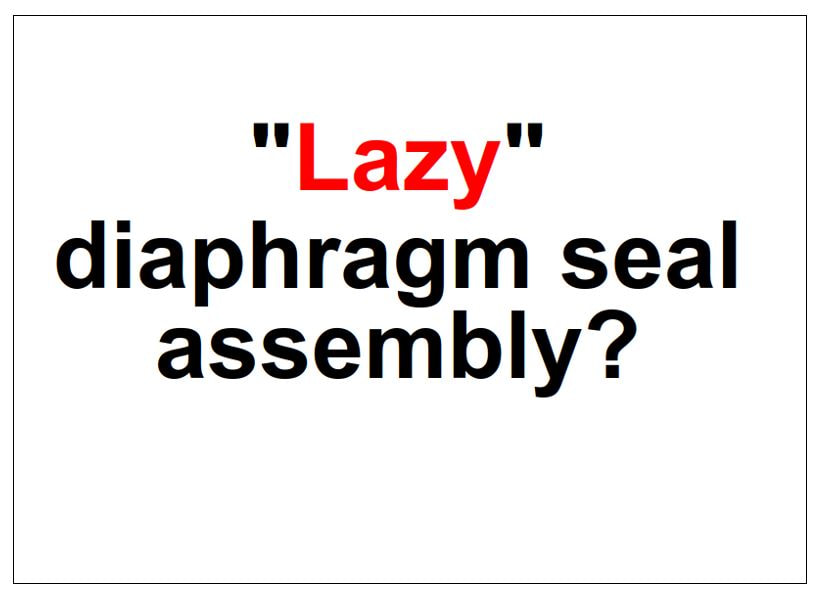The "Lazy" Diaphragm seal :-
Critical response time of Diaphragm seal assembly
The diaphragm seal must have a response time within PST of the process.
But what is PST (Process Safety Time)
IEC 61508:2010 defines Process Safety Time (PST) as “Period of time between a failure, that has the potential to give rise to a hazardous event, occurring in the EUC [equipment under control] or EUC control system and the time by which action has to be completed in the EUC to prevent the hazardous event occurring”
Let us demystify the definition.
In simple words the PST of a given process is the fault-tolerant time of that process, prior to becoming a dangerous condition.
Within this PST the safety system has the opportunity to take necessary action.
Eg:-Closing a valve to prevent overfill or spillage in Tanks.
Why is PST important ?
Within This PST the safety system has the opportunity to take the necessary action to mitigate the hazard and prevent and accident.
Example :- Pressure transmitter senses very high pressure inside tower and opens the valve connected on the vent line to release the excess pressure.
Why is PST is a concern for diaphragm seal assembly ?
There is a delay between the time when diaphragm seal membrane senses pressure and when this is transmitter to the Transmitter.
A variety of factors that affect diaphragm seal response time are:-
1.Size of Flange
2.Capillary length and diameter of capillary tube
3.Fill fluid of diaphragm seal assembly
4.Process temperature and ambient temperature
5.Vacuum condition
Hence if your transmitter is responsible to detect safety critical issue (SIL Transmitter) and if the overall response time of transmitter and entire diaphragm seal assembly is greater that PST then accident is bound to occur.
Even if the issue is detected it will still be of very little use as the process has already reached a dangerous condition.
How to mitigate this issue ?
Evaluate the response time of your diaphragm seal assembly.
All major suppliers have their software that replicate the real time conditions and the response of their diaphragm seal assembly under these conditions.
Note that even though fill fluids having similar names like “Silicone oil”. They are divided into various grades and thus the vendors must be consulted for accurate response time and other characteristics for critical application.
Vendor calculation tools come handy to give a baseline idea whether the diaphragm seal system’s response time is within the PST or not.
A practical example.
Let’s us take case study of the Client SHELL and Vendor Badotherm.
Shell Pernis had been using diaphragm seal pressure transmitter for their safety function.
A typical situation is when temperature in reactor reaches 300-400°C and this point the fill fluid will boil because of low vapor pressure and on top of it the outside temperature is -20°C which would make the viscosity high.
In this situation it is difficult to ascertain what could be the response time of the system.(Incase the fluid is completely in vapor state then obviously an incorrect reading would be shown).
Hence badotherm came up with a tool "Basecal" to simulate conditions and assure the response of diaphragm seal system.
A whitepaper published by badotherm explains this concept in detail.
Here’s the link to it.
http://www.badotherm.com/downloads.html
When to check this response time?
This should be carried out for critical systems like Diaphragm seal connected to Safety systems with long capillary lengths or challenging environmental conditions.
Thanks for reading.
Hope its been of value to you.
PS:This is as per best of my current understanding
To receive such engineering post and relevant job openings “once” every alternate weekend you could jump in to the free newsletter below.
Please note this Newsletter is truly free not just from monetary point of view but also free from any spams or advertisements.
But what is PST (Process Safety Time)
IEC 61508:2010 defines Process Safety Time (PST) as “Period of time between a failure, that has the potential to give rise to a hazardous event, occurring in the EUC [equipment under control] or EUC control system and the time by which action has to be completed in the EUC to prevent the hazardous event occurring”
Let us demystify the definition.
In simple words the PST of a given process is the fault-tolerant time of that process, prior to becoming a dangerous condition.
Within this PST the safety system has the opportunity to take necessary action.
Eg:-Closing a valve to prevent overfill or spillage in Tanks.
Why is PST important ?
Within This PST the safety system has the opportunity to take the necessary action to mitigate the hazard and prevent and accident.
Example :- Pressure transmitter senses very high pressure inside tower and opens the valve connected on the vent line to release the excess pressure.
Why is PST is a concern for diaphragm seal assembly ?
There is a delay between the time when diaphragm seal membrane senses pressure and when this is transmitter to the Transmitter.
A variety of factors that affect diaphragm seal response time are:-
1.Size of Flange
2.Capillary length and diameter of capillary tube
3.Fill fluid of diaphragm seal assembly
4.Process temperature and ambient temperature
5.Vacuum condition
Hence if your transmitter is responsible to detect safety critical issue (SIL Transmitter) and if the overall response time of transmitter and entire diaphragm seal assembly is greater that PST then accident is bound to occur.
Even if the issue is detected it will still be of very little use as the process has already reached a dangerous condition.
How to mitigate this issue ?
Evaluate the response time of your diaphragm seal assembly.
All major suppliers have their software that replicate the real time conditions and the response of their diaphragm seal assembly under these conditions.
Note that even though fill fluids having similar names like “Silicone oil”. They are divided into various grades and thus the vendors must be consulted for accurate response time and other characteristics for critical application.
Vendor calculation tools come handy to give a baseline idea whether the diaphragm seal system’s response time is within the PST or not.
A practical example.
Let’s us take case study of the Client SHELL and Vendor Badotherm.
Shell Pernis had been using diaphragm seal pressure transmitter for their safety function.
A typical situation is when temperature in reactor reaches 300-400°C and this point the fill fluid will boil because of low vapor pressure and on top of it the outside temperature is -20°C which would make the viscosity high.
In this situation it is difficult to ascertain what could be the response time of the system.(Incase the fluid is completely in vapor state then obviously an incorrect reading would be shown).
Hence badotherm came up with a tool "Basecal" to simulate conditions and assure the response of diaphragm seal system.
A whitepaper published by badotherm explains this concept in detail.
Here’s the link to it.
http://www.badotherm.com/downloads.html
When to check this response time?
This should be carried out for critical systems like Diaphragm seal connected to Safety systems with long capillary lengths or challenging environmental conditions.
Thanks for reading.
Hope its been of value to you.
PS:This is as per best of my current understanding
To receive such engineering post and relevant job openings “once” every alternate weekend you could jump in to the free newsletter below.
Please note this Newsletter is truly free not just from monetary point of view but also free from any spams or advertisements.







